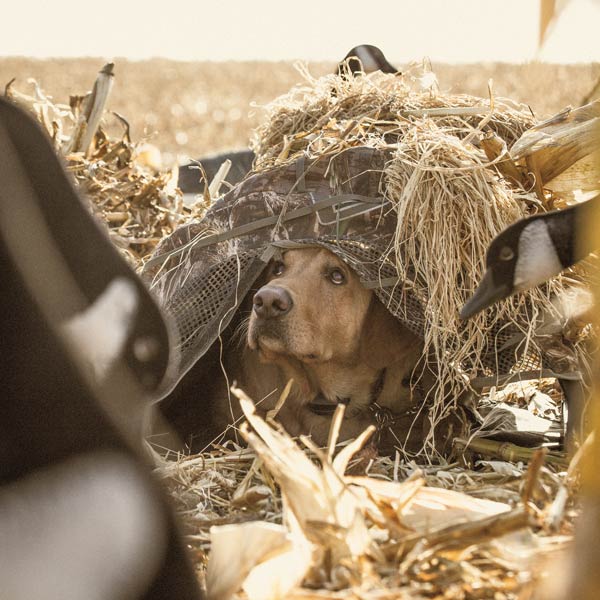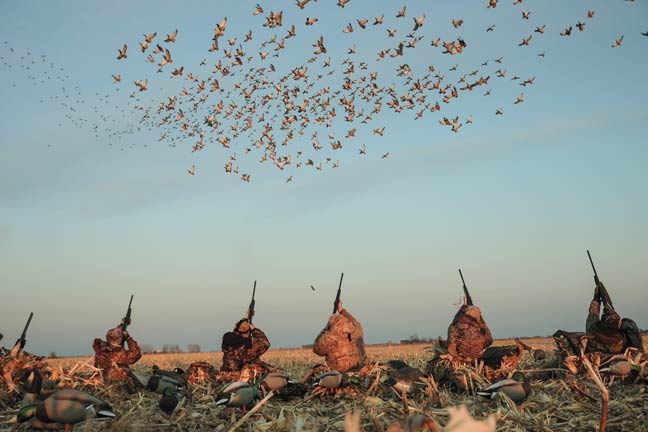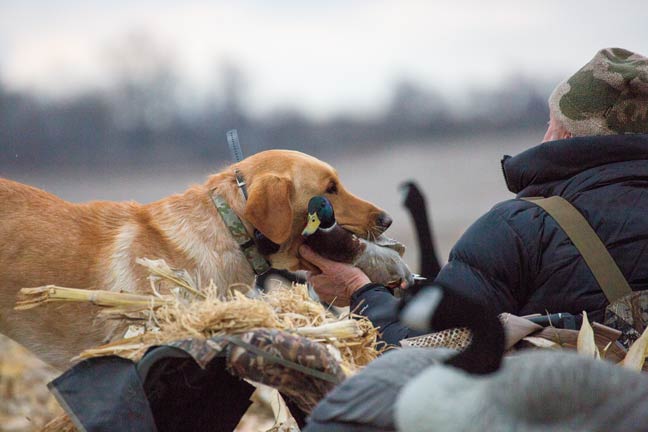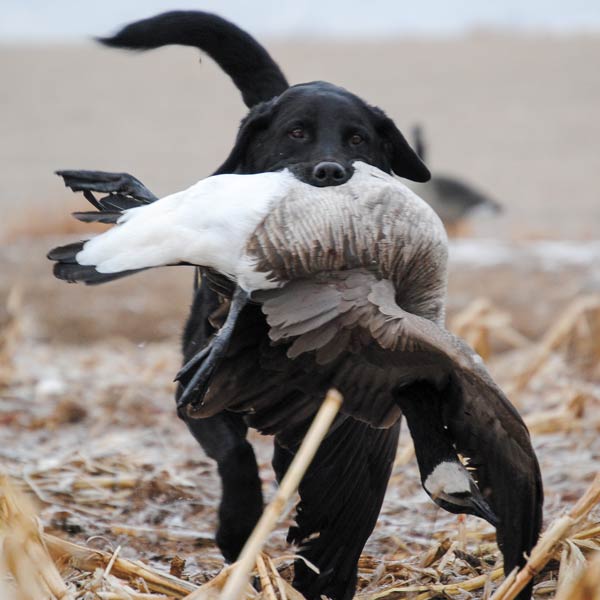North Dakota is the gateway of the Central Flyway, the first stop for migrating ducks and geese traveling south from Saskatchewan. Birds stopping here rely on rolling harvested corn fields to provide the high protein food source they need to continue their journey. This is field hunting at its best, and retrievers here must be prepared to face different challenges than in water.
They were only dots crossing the bluff up from the Missouri River to a huge sea of harvested corn. But they stirred great excitement in the layout blinds positioned among many dozen Canada goose decoys and full-bodied mallards. "Here they come, boys!" exclaimed Jordan Sargent, a lifelong resident of Hazen, North Dakota, and Banded and Avery Outdoors Pro-Staff member.
"They" were mallards, still a long way off but closing the distance quickly at the sight of spinning wings rotating in the spread. The hunters gripped their shotguns a little tighter in the fading November light; these ducks were heading out for a short feed before nightfall. Pleading hail calls caught the wind and funneled upward to the growing flights. The birds were high but heading in the right direction.

Also in the hunting party were Federal cartridge product developers Dan Compton and Rick Stoeckel. They brought along several boxes of the new Black Cloud shot shells for everyone to try. Older variants of this load had trouble with consistent patterns in ported chokes. Dan explained the key changes to the shell, eliminating this issue.
"The redesigned Flitecontrol Flex wad has a stronger brake system due to reinforcing the wad's rear fins with supportive gussets," he said. "Gas pressure inside the barrel flexes the fins to keep them open, triggering the shot to separate from the wad. Ported chokes are designed to vent gasses, and this lowers pressures.
"Our older Black Cloud shell would not pattern consistently through them. Flitecontrol Flex allows the fins open and stay open so payloads separate exactly when they are supposed to, regardless of the pressure level."

Suddenly ducks were high over the decoys but losing altitude at an amazing rate. Feathered bombs dropped straight down and were within 50 yards of the hunters in seconds. Watching them commit from dizzying heights was breathtaking, a sight that stirs even the most seasoned waterfowl hunter to the core. Nothing compares to it, the sheer numbers of northern mallards wheeling into shooting range, mere feet away from the hides.
One more pass and they would be point blank targets. Finally, they were there, 60 mallards slipping and sliding on cupped wings. "Take 'em!" Ducks were slashing and backpedaling in absolute chaos as hunters emerged from ground blinds with shotguns blazing. Shots hit their targets and the new Black Cloud shells did their job and several mallards stayed behind.
Pistol, a two-year-old male yellow Lab, raced back with an emerald headed drake. His owner, Les Naisbitt, here from Nevada, took the bird from him and lined the dog on a hen that fell 20 yards beyond the decoys. Making quick work of that bird, Les looked beyond the decoys. "Anybody see any more ducks go down?"
Hunt host and North Dakota native Jordan Sargent spoke up first. "Yeah, Les, a bird sailed over that rise," he said pointing to the west. Les lined Pistol and sent him on a line to take him over the short hill. The dog raced over the top and out of sight. Pistol hunted the area and soon appeared, another fat drake mallard in his mouth.
During the pandemonium of ducks swirling over the decoys, landing in them, shots fired and ducks falling, Pistol never moved from his hide. Absolute steadiness in situations like these is a must for an effective field retriever. Les' background in field trialing, dating back to springer spaniel trials in 1963, gave him the knowledge of the value in a steady dog.
"I knew what he needed to have in his background to be a good dog for field hunting," he explained. "Big Canada geese in close, ducks piling into the decoys by the hundreds, these try any dog's training level. I work on his steadiness all the time and I didn't shoot on a hunt with him until I was sure he was not going to break."
This is a good lesson for any hunter using a retriever as flocks of live birds and multiple falls with guns blazing cannot be replicated in training. Refraining from shooting is hard to do but worth it to ensure your dog is steady over the long run.
Professional retriever trainer Brad Arrington starts by elevating a pup's prey drive before obedience training. He owns and operates Mossy Pond Retrievers in Patterson, Georgia, and works with trial, hunt test and hunting dogs. His system keys on using birds with young dogs as early as six weeks of age before obedience work.
"What we are looking for in a dog is balance," Brad said. "The best dog needs to be hard charging and highly obedient. To achieve that balance, bird introduction comes early. We use shackled pigeons and quail to ignite the prey drive within a pup. Obedience work begins at five months of age with the dog's attitude monitored closely."
If the dog shows signs of getting "down" during obedience, Brad stops and brings the dog back up with bird work again. "Without having the bird to use as a reward, it's definitely more difficult to maintain a positive attitude with a dog in training," he said. "Only a very rare pup doesn't have a down point in training.
"They are young dogs, all they want to do have fun and making them do what you want them to do is tough on them. When we see a pup's attitude change from enthusiastic to sluggish we get them on birds right away. Those eyes light up again and we get through it."
Field hunting requires a steady dog, so Brad uses high levels of distraction to reinforce the dog staying in place no matter what is happening. "Once we get the obedience foundation set, steadiness is required on every mark thrown. We still throw fun bumpers for the dogs, once again for attitude purposes, but every other retrieve is sent from a sitting position.

"As training progresses, we elevate the amount of distraction to enforce steadiness. I'll have a dog sitting and throw multiple fun bumpers for several dogs at once to create chaos. Then we'll use several gunners to simulate hunting conditions. By the time we are finished with a dog they will have seen many scenarios and know breaking is not an option."
A tool used by many hunter's in open fields with retrievers is the ground blind built for dogs. These popular dog hides are portable, light, and effective. Introducing a dog to these blinds is simple, Arrington says. "Dogs travel in crates and we start with pups as young as six weeks of age on crate training.
We then bring the dog blind into play suing the same 'kennel' command they already know.
"The pup is taught to enter the blind and stay there as part of obedience training. These little blinds are great for field work; they give the dog a place of its own to stay out of the way and hidden during a hunt."
A good field retriever must stay put and out of the way while birds are working. This point cannot be stressed enough. An out of control dog is not only a nuisance but can be very dangerous as well. In the mid 1990s, a group of hunters including a father and his two young sons were hunting in Texas. A young retriever who was not trained completely was picking up birds for the hunters.
Because the dog was not steady, a leash was being used to restrain him. Several geese were shot and the dog broke free with the leash still attached to his collar. Streaking past the hunters, the leash caught on the barrel of a gun held by one of the boys. The violent movement caused the boy to lose control of the loaded firearm and it swung, pointed at the chest of his brother. Tragically, the gun went off and the boy was killed. All of this would have been avoided with a well-trained dog in the spread.
Professional waterfowl guides have even more need for highly trained and steady retrievers. Not only do their dogs need to bring birds back in a quick and efficient manner, they have to be trusted completely to avoid the situation just described. Bill Schaefer hails from the wide-open spaces of Colorado and runs High Desert Waterfowl, an operation devoted primarily to Canada goose field hunting.
Bill recalls fondly growing up not only in a waterfowl hunting family but one that owned and trained Labradors. "My family has always had Labradors. I remember being fascinated as a child watching my father as a self-taught handler working with his black female 'Spree.' I can still see him studying the diagrams of Richard Wolters' Water Dog. I also remember being impressed in seeing how quickly these animals learn and how consistent yet simple work with your retriever made all the difference come fall."

As an adult, Schaefer developed an intense passion for goose hunting. This led in 2008 to the acquisition of "Bomber," a black male Labrador that changed Bill's understanding of both waterfowl hunting and retriever training forever.
"Shortly after getting Bomber, I became involved in our local Hunting Retriever Club and started absorbing as much information as possible," he recalled. "Armed with knowledge and a tremendous amount of hard work, I transformed Bomber from an average hunting dog into a Grand Hunting Retriever Champion. Obtaining this title with such an amazing animal has been one of my life's great accomplishments."
Bill has Bomber by his side guiding clients for three months every season. He prepares his dog well by training in the off season for all the scenarios they will face during the season. A big factor in having a reliable hunting dog is being sure they are physically and mentally ready before ever taking them to the field for real action.
"There is no rush to get your dog on a hunt if they are not ready," Schaefer said. "You absolutely do not want the dog to have a negative experience or form bad habits early in their hunting careers. As a handler, it's extremely important to maintain high standards while hunting, just as you have established in training.
"Don't let months of hard work deteriorate because of being in too much of a hurry to make corrections as needed during a hunt. Reinforcing what your dog knows while hunting is the only way to have a polished and effective hunting partner."
Great gun dogs doen't appear out of thin air; they are the product of countless hours of training. A top-notch field dog is steady, prepared for multiple scenarios, and held to high standards. Following that formula results in a retriever to be proud of.






